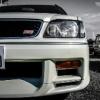Checking Afrs Using Wideband In Tailpipe
Announcements
-
Similar Content
-
Latest Posts
-
Welcome to the new year, gang! We've ticked over into 2024, so as usual, we're starting the new year with a chill social out at Aqua Golf! So without any ado, here are the details: Date: Saturday 22nd March Location: Aqua Golf - Penrith Panthers Time: 4:00pm Map: http://tinyurl.com/saunsw-aquagolf All you need to do is bring yourselves down to Penrith Panthers to come and say "HI", hang out, and maybe hit a few golf balls at the drive range. Who knows where the night may take us... What we do know is that there are plenty of food options available at the Penrith Panthers complex. For those of us keen to hit a few golf balls, prices start from $7.00 a bucket. Aqua Golf is open til late, so we have plenty of time to have a few hits and laughs with each other! This is an official SAUNSW event and will be run under a Motorsport Australia permit. One of the things that really sets our club apart is our commitment to being true enthusiasts. When on normal roads we strive to maintain good relations with the authorities as well as the public in general. When attending one of Skylines Australia NSW events please try to: • Be aware of surrounding environment and act accordingly. • Drive courteously on the state’s roads as a true enthusiast should. • Understand how important it is to maintain the good name of SAU:NSW and thus, treat others accordingly. • Any misbehaviour will not be tolerated and you will be asked to leave. Thanks all! Looking forward to seeing you all there!
-
Kicking off our first Sunday Session for 2025, we'll be heading to the delectable Self Raised Snack Shoppe!! Get your tastebuds ready for a mouth-watering toastie and coffee! As always, this is the best place to meet up with the SAUNSW fam for a coffee, bite to eat, and a chat! So what are you waiting for? Block out the calendar, set your alarm in the morning, and come down to hang out with the SAUNSW fam! Date: Sunday 9th March Meet Location: Self Raised Snack Shoppe - Shop 4, 8/20 Sarsfield Cct, Bexley North NSW 2207 (carpark entry via Slade Road) Meet Time: Meet at 8:00am Map: https://tinyurl.com/saunsw-selfraised This is NOT a race and we will all be adhering to all road rules. If this is what you want please come to one of our many track days. This is an official SAUNSW event and will be run under a Motorsports Australia permit. One of the things that really sets our club apart is our commitment to being true enthusiasts. When on normal roads we strive to maintain good relations with the authorities as well as the public in general. When attending one of Skylines Australia NSW events please try to: • Be aware of surrounding environment and act accordingly. • Drive courteously on the state’s roads as a true enthusiast should. • Understand how important it is to maintain the good name of SAU:NSW and thus, treat others accordingly. • Any misbehaviour will not be tolerated and you will be asked to leave. Thanks guys and hope to see you there!
-
Pre-empting heat management 1. The Kraken manifold will be ceramic coated 2. Just purchased some peel and stick heat shielding stuff from car builders, I'll cover some of the firewall behind the dump and a little on the cam cover, this will be done prior to installation as I have ample room to get where I need to now before that realestate has more bits in the way, I'm also planning to modify the OEM heat shield to go back on, but that won't happen until after installation so I know where to hack it up, I'll also cover it with some some peel and stick to neaten it up after the hacking 3. As the dump is stainless with a flex joint coating isn't really a option, and wrapping isn't recommended for a stainless dump, so once it is installed I'll grab some shielding from car builders to cover the dump, as it has some stand off, it "shouldn't" cause any issues and it "should" just keep the radiant heat away from " melty engine bay stuff" Not for heat management, but I've grabbed some more black crinkle coat to paint all the shiny intake pipes, I'll pick the pipe work up prior to installation and use the paint booth and big oven at work to cure them, I'll then wrap them with some bubble wrap so they stay nice during installation
-
We're back on, gang - Our yearly pilgrimage south to our favourite cafe for an awesome brekkie! Yes, that's right... we're heading down to Austi Beach Cafe for a breakfast run through the Royal National Park! Before you drool over your phones/keyboards, here are the details: Date: Sunday 23rd February Meet Location: Loftus Oval Carpark, Royal National Park, Sutherland Meet Time: Meet at 7:00am for a 7:30am departure Destination: Austi Beach Cafe, 104 Lawrence Hargrave Drive, Austinmer Map: http://tinyurl.com/saunsw-austicruise RSVP: If you are planning to sit and have breakfast with us, please let us know, either by posting in the event, or by messaging us direct so we can confirm numbers with the venue. Itinerary: We will meet at Loftus Oval Carpark which has plenty of room and is low car friendly. This is a quick turn into the Royal National Park and some nice roads and scenery. After Stanwell Tops we will turn off and head onto the awesome Sea Cliff Bridge. Following this it is a short trip to Austi Beach Cafe. There will be a lead and follow car so no one should get lost. If you would like to attend or bring others along please put your name down and a +1 as numbers will be needed prior! This is NOT a race and we will all be adhering to all road rules. If this is what you want please come to one of our many track days. This is an official SAU:NSW event and will be run under a Motorsport Australia permit. One of the things that really sets our club apart is our commitment to being true enthusiasts. When on normal roads we strive to maintain good relations with the authorities as well as the public in general. When attending one of Skylines Australia NSW events please try to: • Be aware of surrounding environment and act accordingly. • Drive courteously on the state’s roads as a true enthusiast should. • Understand how important it is to maintain the good name of SAU:NSW and thus, treat others accordingly. • Any misbehaviour will not be tolerated and you will be asked to leave. Thanks guys and hope to see you there!
-
YO- have been searching and searching for an a31 chassis plug pinout, or someone who knows which wire is for tach. ceffy was flooded past dash during a hurricane. having an electrical gremlin appear. tach is wonky reading consistent with a short, and on occasion the right side of my speedo lighting will flicker just for a second then go back to normal. if no pinout available does anyone know if the tach harness opens or branches anywhere behind the dash? im suspecting a possible root behind the radio as there are more shorts in that area on the accessory loop.
-






Recommended Posts
Create an account or sign in to comment
You need to be a member in order to leave a comment
Create an account
Sign up for a new account in our community. It's easy!
Register a new accountSign in
Already have an account? Sign in here.
Sign In Now